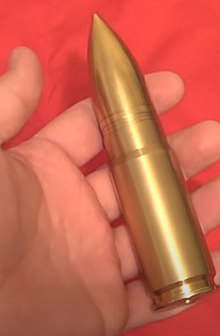The .950 JDJ (24.1×70mm) is an obsolete powerful large caliber rifle cartridge developed by American gunsmith and weapon designer J. D. Jones of SSK Industries.
| .950 JDJ | ||||||||
|---|---|---|---|---|---|---|---|---|
 A .950 JDJ | ||||||||
| Type | Rifle | |||||||
| Place of origin | United States | |||||||
| Production history | ||||||||
| Designer | J. D. Jones | |||||||
| Manufacturer | SSK Industries/Knight Rifles | |||||||
| Specifications | ||||||||
| Parent case | 20×102mm Vulcan | |||||||
| Bullet diameter | 0.950 in (24.1 mm) | |||||||
| Case length | 2.75 in (70 mm) | |||||||
| Ballistic performance | ||||||||
| ||||||||
Cartridge
edit.950 JDJ cases are approximately 70 mm in length, and are based on a 20×102mm Vulcan case shortened and necked up to accept the .950 in (24.1 mm) bullet. Projectiles are custom-made and most commonly weigh 3,600 grains (230 g) which is 8.2 ounces or over half a pound.[1]
Rifles
editAs its name implies, rifles[2][3] chambered for the cartridge have a groove diameter of 0.950 in (24.1 mm). SSK received a "Sporting Use Exception" to de-regulate the rifles. Thus, in the United States, they can be owned like any other Title I rifle by an American citizen at age 18. The rifles use stocks and extraordinarily thick Krieger barrels bearing an 18 lb (8.2 kg) muzzle brake.[1] Overall, depending on options, the rifles weigh from 85 to 120 pounds (39 to 54 kg) and are therefore only useful for shooting from a bench rest or heavy bipod.[2] Despite the weight, recoil is significant and shooters must be sure to choose components (i.e., scopes and bipods) that can handle the force. The sheer size, weight, and power of these rifles make them rather impractical for hunting use. SSK only manufactured three of these rifles and as of 2014 no longer produces the ammunition.[1][4]
Ballistics
editThe cartridge propels its 3,600 grains (233 grams) bullet at approximately 2,200 feet per second (670 metres per second).[1] This yields a muzzle energy of 38,685 foot-pounds force (52,450 joules).[3]
By comparison, the 5.56×45mm NATO cartridge, used in the M16 and M4 rifles, produces between 1,200–1,300 foot-pounds force (1,600–1,800 joules), while the .308 Winchester, a favorite for hunters, police, and military snipers, produces between 2,000–3,000 foot-pounds force (2,700–4,100 joules) depending on the load used. Even the .50 BMG, which has a kinetic energy of around 13,000–15,000 foot-pounds force (18,000–20,000 joules) delivers less than half the energy. The ballistics of the .950 JDJ are more similar to that of the 20 mm autocannon round, which delivers approximately 39,500 foot-pounds force (53,600 joules). The muzzle energy of the .950 JDJ is comparable to the kinetic energy of a 2,800 pounds (1,300 kilograms) automobile traveling at 20 miles per hour (32 kilometres per hour).
In a 110 lb (50 kg) rifle, this will develop well over 200 foot-pounds force (270 joules) of free recoil energy. Shooting usually involves a heavy "lead sled" or similar shooting rest, and the rifle scope has significant eye relief to avoid injuring the ocular orbit.[citation needed]
References
edit- ^ a b c d Barnes, Frank C. (19 December 2014). Cartridges of the World: A Complete and Illustrated Reference for Over 1500 Cartridges (14th ed.). Iola, Wisconsin: F+W Media, Inc. p. 416. ISBN 978-1-4402-4265-6.
- ^ a b McBros 95 caliber rifle single-shot bolt-action rifle, Securityarms.com
- ^ a b "The SSK Industries .950 JDJ – The Largest Centerfire Rifle Ever Made". SoldierSystems. 2014.
- ^ Rottman, Gordon L. (2013). The Big Book of Gun Trivia: Everything you want to know, don't want to know, and don't know you need to know. Bloomsbury Publishing. p. 288. ISBN 978-1-78200-950-4.
External links
edit- "Fat Mac" - SSK Industries' .950 JDJ Rifle Forgotten Weapons